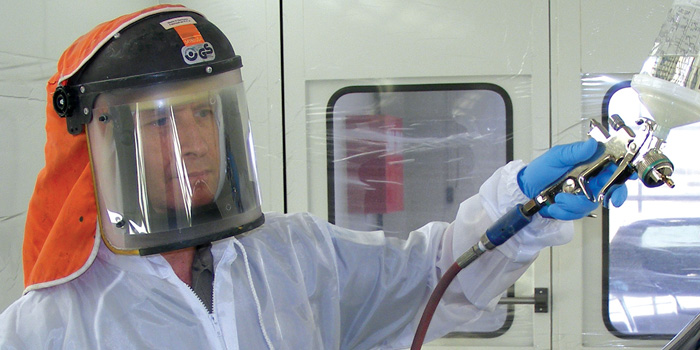In the “Health & Safety” column in the March 2016 issue of BodyShop Business, we talked about the king of personal protective equipment, the respirator. In a shop, workers are exposed to several different hazards that require the use of a respirator, but the choice of respirator determines the effectiveness of the protection. In this column, we’ll discuss the types of respirators most often used in body shops.
As part of OSHA’s Respiratory Protection standard, employers must develop a written respiratory protection program specific to the hazards of that workplace. They must select and provide respirators appropriate to the workplace and to the particular hazards to which employees will be exposed. Respiratory protection is necessary “in all situations where engineering and administrative controls are insufficient to reduce airborne hazards, in emergencies, in situations in which engineering and other controls are being installed or maintained, in oxygen-deficient atmospheres, or for internal structural firefighting.”
Types of Respirators
It’s essential to select the proper protective equipment, but these selections should be made with several things in mind, such as the evaluation of the workplace environment, types of job functions that are performed in the shop, identification of reasonably foreseeable emergencies, employee health conditions and unique facial characteristics that may affect proper use. This assessment should be done by experienced safety personnel or an industrial hygienist. Selected respirators must be certified by the National Institute for Occupational Safety (NIOSH) and used in compliance with the conditions of certification. The following are the types of respirators most commonly found in shops:
- Particulate respirators. Also known as dust masks, these are simple to use and inexpensive but don’t provide much protection. They’re generally made of cloth and only protect against particles such as dust. They do not protect against chemicals, gases or vapors. They’re usually disposable and must be replaced when they become discolored, damaged or clogged. It’s important to note that single-strap dust masks are usually not NIOSH-approved and not appropriate for a shop environment.
- Chemical cartridge/gas mask respirator. These air-purifying respirators filter or clean chemical gases out of the air as you breathe. They include a half or full facepiece or mask, and a cartridge or canister. This respirator is used with straps that secure the facepiece to the head. The cartridge may also have a filter to remove particles. Filters and cartridges must be chosen carefully to protect against the hazards found in your shop. They can be made from a variety of materials, including silicone, neoprene and rubber. Keep in mind that half-piece respirators don’t provide eye protection, which is required under OSHA regulations if workers will have contact with harmful spray mists.
- Powered air-purifying respirator. These respirators use a fan to draw air through the filter to the user. They’re easy to breathe through but require a fully charged battery. Because they’re loose-fitting, they can be worn by most workers who have beards. They use the same types of filters and cartridges as other air-purifying respirators.
- Supplied-air systems. In these respirators, air is supplied from a stationary source of compressed air. When delivering sufficient and properly maintained air, supplied-air systems can provide better protection from isocyanate-containing paint mists and organic vapors than cartridge-type respirators. Clear plastic sheets can protect the lens from overspray, and kits can be ordered for employees who need vision correction.
Other Considerations
When choosing respirators, don’t forget about written physician approval and fit-testing. Breathing through a respirator is more difficult than breathing in open air. Each time an employee starts at a job where clear working conditions or job requirements exist that require a respirator, he or she must receive written approval from a physical or other licensed healthcare professional before wearing that respirator.
After approval, an employee must be fit-tested for a tight-fitting respirator before he or she uses one. Here’s why: If the mask does not make a tight seal all the way around the face when the worker inhales, the worker will breathe contaminated air that leaks around the edges of the face seal. Most respirators come in different sizes and styles, and fit people differently based on their face shape and whether they have facial hair. Like other PPE, respirators must be checked for proper fit each time workers put them on to ensure they have adequate protection.
Also, employers are required by law to provide an annual written respiratory review for workers using respirators. The form is filled out by the employee and then submitted to a physician or licensed healthcare professional, who will then determine whether a physical checkup is necessary.
Employers should establish and adhere to schedules for cleaning and disinfecting, storing, inspecting, repairing and maintaining respirators. Finally, don’t forget to evaluate your respirator program periodically to make sure it’s effective, especially when working conditions change.














